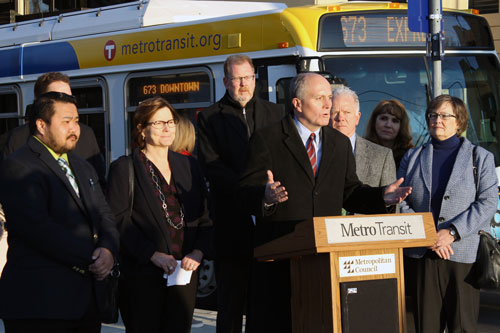Commuters, business leaders, local elected officials and Metropolitan Council Chair Nora Slawik joined together Friday at a busy park-and-ride facility in the west metro to emphasize the need for increased investment in modern transit that gets people to work and school.
 As commuters boarded Metro Transit and Plymouth Metrolink express buses at the County Road 73 Park & Ride in Minnetonka, the group emphasized that there are more than 100 park and ride facilities across the region. County Road 73 Park & Ride is one of the busiest in the region, connecting commuters from Minneapolis, Minnetonka, Mound, St. Louis Park, and Wayzata to their places of employment. On a typical weekday, 500 cars park at the location.
As commuters boarded Metro Transit and Plymouth Metrolink express buses at the County Road 73 Park & Ride in Minnetonka, the group emphasized that there are more than 100 park and ride facilities across the region. County Road 73 Park & Ride is one of the busiest in the region, connecting commuters from Minneapolis, Minnetonka, Mound, St. Louis Park, and Wayzata to their places of employment. On a typical weekday, 500 cars park at the location.
“500 cars at a park and ride like this one means 500 fewer cars on highways like I-394. No matter where you live, people need access to reliable transit,” said Slawik. “The governor’s proposal would mean more investment in suburban transit options. This funding increase would be in addition to enhancements to customer experience, maintenance, security, and accessibility, which would benefit suburban transit commuters all across the region.”
“There are more jobs in Minnetonka than there are adults,” said Minnetonka Mayor Brad Wiersum. “A thriving transportation system is essential for people who commute to Minnetonka every day.”
Governor Walz’s $1.5 billion transit package centers on investing in the state’s bus network — the workhorse of the system — including more revenue for suburban opt-out transit providers. The proposal would result in $2 million more each to the suburban providers, as a result of the proposed increase in the Motor Vehicle Sales Tax (MVST) rate from 6.5% to 6.875%.
“Suburban commuters benefit when the bus shelter they arrive at in downtown Minneapolis is in good shape,” said Met Council District 3 Member Chris Ferguson, whose district includes Wayzata, Eden Prairie, and more. “They benefit when their suburban express bus connects them with more transit options, whether it’s BRT [bus rapid transit], regular-route bus, or light rail. This proposal will build community prosperity by helping families who use public transit, residents who rely on transit to get to work or school, and businesses that attract and retain a workforce that increasingly wants to use transit.”
Governor Walz’s budget proposal includes the biggest expansion in local bus service in a generation, including 10 Bus Rapid Transit lines across the region and 220 electric buses over the next decade.
By 2040, the Twin Cities metro region is projected to add an additional 700,000 people. That growth is similar to having North Dakota’s entire population move into the 7-county metro. The region is also expected to add 500,000 jobs. With that level of growth, the demand for modern, fast and reliable transit options will increase.
“Our region must have comprehensive, modern transit that ensures we’re prepared to grow and succeed,” said Jonathan Weinhagen, president and CEO of the Minneapolis Regional Chamber. “Transit investments strengthen our economy — both by generating good jobs at manufacturing businesses across Minnesota and by providing better access to jobs by transit in the Twin Cities and Greater Minnesota. Expanded and improved public transit is broadly popular among Minnesotans and we need to make progress on it now, or risk losing jobs to other regions.”
“We moved our company to downtown Minneapolis to be part of the vibrant business community in the city,” said Chris Behrens, CEO of YA. “Many of our employees are part of the forty percent of downtown employees who get to and from work using transit. Investments in transit to improve the rider experience and service will pay big dividends for our entire region.”
“More and more businesses in downtown Minneapolis are relying on transit to get employees to work,” said Steve Cramer, president and CEO of the Downtown Council. “Downtown can be congested — that’s a sign that our economy is strong, and the good news is that when quality transit is available, people from all walks of life use it to make their lives better. Better transit benefits both those using it and those who aren’t — 40 people on a bus means 40 fewer cars in front of you if you’re in traffic. But we need stable, ongoing funding that responds to the significant need we see as more businesses and residents come to downtown Minneapolis.”
More about the 2019 transit budget